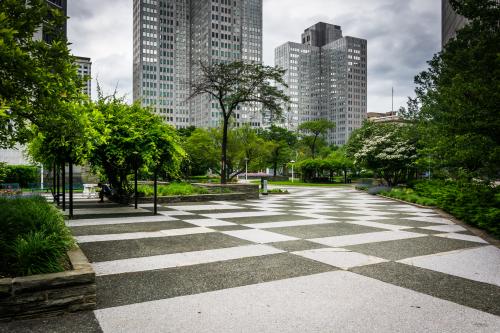The demolition of a public housing complex in the nation’s capital has sparked a fight over something more than displacement and gentrification: It has come to represent a larger struggle over the preservation of Black history, culture, and space amidst sweeping socio-economic and demographic change.
A historic preservation hearing last Thursday brought this struggle to a head, asking District officials to confront questions that scale far beyond just one neighborhood or place, namely: Whose history matters in our public realm, and how should this history be preserved as a city changes?
At the center of this debate is Barry Farm, a public housing complex in the District’s Southeast quadrant, nestled out of view from the tourist attractions, landmarks, and museums the city is known for. The complex—which has most recently come to be known for its poverty, high crime rates, and dilapidated conditions—is being demolished to make room for mixed-income housing units and retail, prompting the relocation of over 200 families in the process.
This is not a situation unique to the District, but has taken on heightened meaning in a city facing some of the most intense levels of gentrification in the country. Tensions are high and some community members have decided to hold up the process with one controversial, but monumental request: make the last 32 remaining Barry Farm buildings a historic landmark.
Whose history gets recognized in our public spaces?
In a city defined by its historical landscape, some residents want recognition of another story critical to the region’s history. They are pointing to inequities in whose history gets memorialized, and are arguing that the historical legacy of the public housing complex, no matter how uncomfortable it may be, deserves to be preserved within the physical remnants of the building itself.
While Barry Farm is now largely perceived as a symbol of the larger socio-economic disparities dividing the District, these residents are reminding officials that it was one of the first places to provide freed slaves with affordable housing in the wake of the Civil War, was home to prominent political figures including Frederick Douglass, was instrumental in funding Black institutions such as Howard University, and ultimately became integral in the fight to desegregate schools and improve welfare and upward mobility for Black people. Rather than associating the complex with its troubled present, they want future generations to be able to witness and appreciate its vital past.
For the District review board, the issue is a bit more complicated. Citing legitimate concerns over unsafe physical conditions in the complex, the pressing need for more affordable housing in the neighborhood, and the lengthy process accompanying landmark status, they concluded Thursday’s hearing by asking these former residents to wait for an answer. This is the third time they have been asked to wait.
The importance of embedding history and culture within public space
Ultimately, the fight over Barry Farm is about more than those last 32 buildings left standing. It signifies a larger struggle over representation in our physical spaces, one that has only intensified as cities become more divided, unaffordable, and unequal. This struggle has manifested itself in a myriad of ways, from efforts to remove racist memorials from public plazas to movements to protect Black culture on rapidly gentrifying blocks. Within all these actions is one critical, underlying message: Black history matters.
Ultimately, the fight over Barry Farm is about more than those last 32 buildings left standing. It signifies a larger struggle over representation in our physical spaces, one that has only intensified as cities become more divided, unaffordable, and unequal.
This message is backed up by research and lived experience. Embedding symbols of history and culture within our public realm has been shown to foster pride in one’s identity and transmit heritage to younger generations—a critical social function as our education system continues to prioritize some histories over others. It serves to dispel myths and destructive stereotypes about people of color, strengthen social mobility and cohesion among diverse groups, and make evident the harms caused to marginalized communities. These benefits are about more than just physical tweaks to our public realm: They are about correcting past injustices, uplifting underrepresented groups, and preserving history that may otherwise be lost. But more people and places need the chance to experience these benefits.
How can places preserve their history and culture, while also improving neighborhood conditions?
Some Barry Farm residents have identified one way to preserve history within place. This particular strategy is characterized by a difficult set of challenges that must be weighed and considered to maximize community benefit, but regardless of its outcome, it has brought attention to a critical issue. In communities across the country, there exists an urgent need—and a growing will—to not only embed Black history and culture in spaces when they are being threatened, but also when they are being built from the ground up.
Planners, developers, and city leaders must recognize and work harder to embed underrepresented history and culture in our spaces not only when tensions are high, but as consistent, integral components of our efforts to promote inclusive growth in communities.
Planners have begun to acknowledge representation gaps in our public realm, particularly of women and people of color. Some propose diasporic placemaking as a solution—a community-driven planning process that seeks to address legacies of exclusion, center history in urban design, and promote cultural revitalization along with economic growth. Others stress the importance of cultural equity plans in redressing historical harm, arguing that such plans bring an explicit racial and ethnic demographic lens to planning and infuse underrepresented history and culture as a critical component of our public spaces. Finally, others are taking it upon themselves to build sculptures, murals, and exhibits that explicitly call out the lack of historical representation in our public realm, and to devote entire districts to celebrating Black art, music, and culture. Regardless of their form, these efforts are planting seeds for a larger movement that takes seriously the role of history, harm, and resistance in our urban landscape.
As cities change, diversify, and confront a new set of inequity challenges, the need to scale these efforts is only growing. On Thursday, Barry Farm residents were asked to wait yet again for their history to be acknowledged. But people—in Barry Farm and elsewhere—should not have to wait, and should not be asked to advance these efforts alone. Planners, developers, and city leaders must recognize and work harder to embed underrepresented history and culture in our spaces not only when tensions are high, but as consistent, integral components of our efforts to promote inclusive growth in communities.








Commentary
Making Black history matter in public space
October 2, 2019